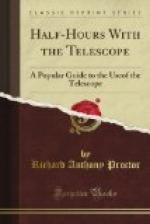So far as my own experience goes, I consider that the five larger satellites may be seen distinctly in good weather with a good 3-1/2-inch aperture. I have never seen them with such an aperture, but I judge from the distinctness with which these satellites may be seen with a 4-inch aperture. Titan is generally to be looked for at a considerable distance from Saturn—always when the ring is widely open. Japetus is to be looked for yet farther from the disc. In fact, when Saturn comes to opposition in perihelion (in winter only this can happen) Japetus may be as far from Saturn as one-third of the apparent diameter of the moon. I believe that under these circumstances, or even under less favourable circumstances, Japetus could be seen with a good opera-glass. So also might Titan.
Transits, eclipses, and occulations of Saturn’s satellites can only be seen when the ring is turned nearly edgewise towards the earth. For the orbits of the seven inner satellites lying nearly in the plane of the rings would (if visible throughout their extent) then only appear as straight lines, or as long ellipses cutting the planet’s disc.
The belts on Saturn are not very conspicuous. A good 3-1/2-inch is required (so far as my experience extends) to show them satisfactorily.
The rings when turned edgewise either towards the earth or sun, are not visible in ordinary telescopes, neither can they be seen when the earth and sun are on opposite sides of the rings. In powerful telescopes the rings seem never entirely to disappear.
The shadow of the planet on the rings may be well seen with a good 2-inch telescope, which will also show Ball’s division in the rings. The shadow of the rings on the planet is a somewhat more difficult feature. The shadow of the planet on the rings is best seen when the rings are well open and the planet is in or near quadrature. It is to be looked for to the left of the ball (in an inverting telescope) at quadrature preceding opposition, and to the right at quadrature following opposition. Saturn is more likely to be studied at the latter than at the former quadrature, as in quadrature preceding opposition he is a morning star. The shadow of the rings on the planet is best seen when the rings are but moderately open, and Saturn is in or near quadrature. When the shadow lies outside the rings it is best seen, as the dark ring takes off from the sharpness of the contrast when the shadow lies within the ring. It would take more space than I can spare here to show how it is to be determined (independently) whether the shadow lies within or without the ring. But the ‘Nautical Almanac’ gives the means of determining this point. When, in the table for assigning the appearance of the rings, l is less than l’ the shadow lies outside the ring, when l is greater than l’ the shadow lies within the ring.
Uranus is just visible to the naked eye when he is in opposition, and his place accurately known. But he presents no phenomena of interest. I have seen him under powers which made his disc nearly equal to that of the moon, yet could see nothing but a faint bluish disc.




